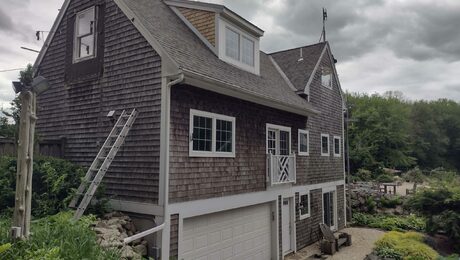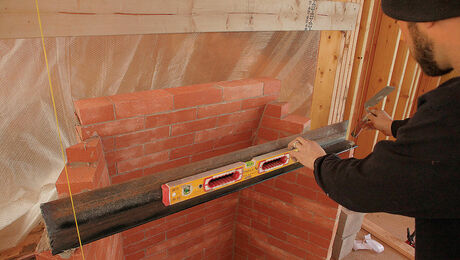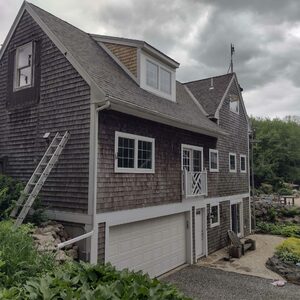my subfloor has been glued and stapled down with 2″ staples every 4″ to 6″. For insurance I want to screw the 5/8″ plywood down. What spacing should I go with?
Discussion Forum
Discussion Forum
Up Next
Video Shorts
Featured Story

Listeners write in about ventilation and radon control and ask questions about tightening basement garages, ventilation solutions, and safer paint stripper.
Featured Video
Video: Build a Fireplace, Brick by BrickHighlights
"I have learned so much thanks to the searchable articles on the FHB website. I can confidently say that I expect to be a life-long subscriber." - M.K.
Fine Homebuilding Magazine
- Home Group
- Antique Trader
- Arts & Crafts Homes
- Bank Note Reporter
- Cabin Life
- Cuisine at Home
- Fine Gardening
- Fine Woodworking
- Green Building Advisor
- Garden Gate
- Horticulture
- Keep Craft Alive
- Log Home Living
- Military Trader/Vehicles
- Numismatic News
- Numismaster
- Old Cars Weekly
- Old House Journal
- Period Homes
- Popular Woodworking
- Script
- ShopNotes
- Sports Collectors Digest
- Threads
- Timber Home Living
- Traditional Building
- Woodsmith
- World Coin News
- Writer's Digest


















Replies
May as well go with the standard - 6" spacing along sheet edges, 12" centres in the field.
I'll be the first to admit I don't know much about staples - especially for subfloor. I have found though that very acceptable results can be had via nails and lots of glue ("mucho pegamento"). Screws are not essential. Hear is a trick though: After the house has set for a while (but obviously before any finished flooring or sheetrock is installed), slowly and carefully walk all around the house on a Sunday or sometime when no one else is around - no other noise. If there are any squeaks or creeks you will find them. 5/8 subfloor sounds kind of minimal though...
Anyway, to answer your Q - as the previous guy said, code and accepted practice is 6" on supported edges, 12" in the center of the sheets.
Another thing you might want to do is look at the underside for "shiners" - fasteners that missed the framing. The ones that just barely missed but are up against the side of a joist are a real squeak causer. They need to be extracted. They will probably be a bear to get out but there should only be a few that meet the criteria.
Thanks for responses both of you....
We always used staples 'cause it's very fast laying the subfloor down. I've actually been quite surprised at the holding power of staples as I've had the misfortune of having to pull up plywood that has been stapled, dang near tears the plywwod to shreds as the staples have held while the plywood pulls apart.
were staples lack is their shear strengh. I know that all the builders that I have framed for in the past have always screwed down their floor. Since that was what they have planned to do we always used staples.I just have never been around when they were screwing down the floor, I wondered if they went if the minimum or went closer.
I know that 5/8 is minimum code, but that is what my budget allowed for, and is what is being used in the subdivision where I am building. I prefer 3/4" I have always framed in higher end homes where 3/4" ply is used. maybe the next one.
PS...all missed staples were popped and restapled at time of installation - I made sure of it.
Thanks for tips....12 oc and 6 in the field sounds good to me.
I've had the misfortune of removing wall and roof sheathing that was stapled. I know whay you mean about the holding power.... Just never used it on floor sheathing. Seing someone stapling off sheathing with one of those full auto guns is something, Was working in a subdivision one time and just had to go see what that noise was. The guy was on a roof and all the sheathing was already tacked in place - I'm telling you he was like a machine...
Best thing for screws is to get a Quickdrive. Do a google or check Amazon.
If I'm doing a subfloor on 2 1/2" I joists or even better the 3 1/2" which is mostly what I've worked with. If you got the right gun ( some bounce better than others) man you can fly.... machine gun fast.
my floor is 2x10 and my stapler isn't the best bouncer, but it still goes 2 times as fast as using a gun. and since I want to screw it down anyways I like to do the initial fastening with the stapler.
it looks like my local building supply store can rent me an auto screw gun for $25 for a day. I've got it reserved for saturday.
P.S. incedently, there isn't a squeek to be found at this point in time. I just want it to stay that way.
Edited 12/14/2005 8:01 pm ET by alrightythen
What is the finish floor going to be?
'Nemo me impune lacesset'
No one will provoke me with impunity
laminate....gag.. gag ...cough (budget)
and carpet. also hoping to get a bit of tile in the bathrooms.
also hoping to get a bit of tile in the bathrooms.
Tiles will not survive on 5/8" subfloor (and CBU doesn't do anything to help, it isolates the tiles from expansion/contraction of the plywood but does not overcome deflection in such a thin subfloor). 3/4" minimum and TLCA recommends 1-1/8" (two layers of 5/8").
Taylor, I laid about 600 sf of tile over a 5/8" subfloor over 2x8 joists. I installed a drypack mud base and I never had any grout cracking. I've looked at that floor after ten years an no problems are evident.
blue
It also depends on the span of the joists, the spacing of the joists, and how much karma you built up in your previous lives.....
Interesting. What do you do about the 5/8" difference in floor heights (where the 1 1/4" subfloor under the tile borders a 5/8" subfloor)?
The crew I work for uses 3/4 T&G, then glues and nails( well, I nail...I'm the fastest with the gun), typically with ring shank nails. I use a 6 and 12 schedule, or whatever the plans spec out.
Young, poor, and eager to learn
I'm curious about this and will need to ask my neighbor as well. Let me explain ...
How does one know if the staples that are already in the subflloor actually where they are suppose to be? I ask, because I've seen more P-P construction with a lot of missed nailing than actually the right way. So, now you have sealed joist cavities and I am curious how you will go about screwing? Do you assume the staples are correct?
About three years ago my neighbor learned that the carpeting in his new track home had failed. The carpet manufacturer replaced the material, but he did the installation. While the old carpet was out, he took the opportunity to screw down the subfloor because the glue and nails did nothing to offset the problems created by using 24" OC joist spacing with 1/2" OSB subflooring--ahh, southern construction.
My concern would be that staples were probably a lot less destructive when put into place even with some moderate offset (i.e. not centered on the joists), but a screw is another thing and bites into wood. So, if the screw taps into the joist near the edge of the joist top it could cause damage, no?
An advantage of screws is that you can tell when you missed.We replaced our LR carpet recently. Took advanage of the opportunity to screw down an area that was pretty squeeky. Used a small drill bit and wire to find the joists -- turns out that joist spacing varied from 14" to 18". Large areas of the underlayment were not attached to anything other than the subfloor.
If ignorance is bliss why aren't more people
happy?
If it's already glued and stapled you don't need to do the full schedule with screws. Between every other staple would probably be about right.
happy?
Great minds think alike.
J. D. Reynolds
Home Improvements